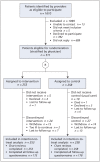Individualized electronic decision support and reminders to improve diabetes care in the community: COMPETE II randomized trial
- PMID: 19581618
- PMCID: PMC2704409
- DOI: 10.1503/cmaj.081272
Individualized electronic decision support and reminders to improve diabetes care in the community: COMPETE II randomized trial
Abstract
Background: Diabetes mellitus is a complex disease with serious complications. Electronic decision support, providing information that is shared and discussed by both patient and physician, encourages timely interventions and may improve the management of this chronic disease. However, it has rarely been tested in community-based primary care.
Methods: In this pragmatic randomized trial, we randomly assigned adult primary care patients with type 2 diabetes to receive the intervention or usual care. The intervention involved shared access by the primary care provider and the patient to a Web-based, colour-coded diabetes tracker, which provided sequential monitoring values for 13 diabetes risk factors, their respective targets and brief, prioritized messages of advice. The primary outcome measure was a process composite score. Secondary outcomes included clinical composite scores, quality of life, continuity of care and usability. The outcome assessors were blinded to each patient's intervention status.
Results: We recruited sequentially 46 primary care providers and then 511 of their patients (mean age 60.7 [standard deviation 12.5] years). Mean follow-up was 5.9 months. The process composite score was significantly better for patients in the intervention group than for control patients (difference 1.27, 95% confidence interval [CI] 0.79-1.75, p < 0.001); 61.7% (156/253) of patients in the intervention group, compared with 42.6% (110/258) of control patients, showed improvement (difference 19.1%, p < 0.001). The clinical composite score also had significantly more variables with improvement for the intervention group (0.59, 95% CI 0.09-1.10, p = 0.02), including significantly greater declines in blood pressure (-3.95 mm Hg systolic and -2.38 mm Hg diastolic) and glycated hemoglobin (-0.2%). Patients in the intervention group reported greater satisfaction with their diabetes care.
Interpretation: A shared electronic decision-support system to support the primary care of diabetes improved the process of care and some clinical markers of the quality of diabetes care. (ClinicalTrials.gov trial register no. NCT00813085.).
Figures
Comment in
-
Improving primary care for patients with complex chronic diseases: can health information technology play a role?CMAJ. 2009 Jul 7;181(1-2):17-8. doi: 10.1503/cmaj.091101. CMAJ. 2009. PMID: 19581613 Free PMC article. Review. No abstract available.
References
-
- National diabetes statistics 2007. Bethesda (MD): National Diabetes Information Clearinghouse; 2008. [(accessed 2009 Jan. 21)]. Available: http://diabetes.niddk.nih.gov/dm/pubs/statistics/#14.
-
- The prevalence and costs of diabetes. Toronto (ON): Canadian Diabetes Association; [(accessed 2009 Jan. 21)]. Available: www.diabetes.ca/about-diabetes/what/prevalence/
-
- American Diabetes Association. Standards of medical care in diabetes — 2007. Diabetes Care. 2007;30(Suppl 1):S4–41. - PubMed
-
- UK Prospective Diabetes Study Group. Intensive blood-glucose control with sulphonylureas or insulin compared with conventional treatment and risk of complications in patients with type 2 diabetes (UKPDS 33) [published erratum in Lancet 1999;354:602] Lancet. 1998;352:837–53. - PubMed
Publication types
MeSH terms
Associated data
LinkOut - more resources
Full Text Sources
Medical

